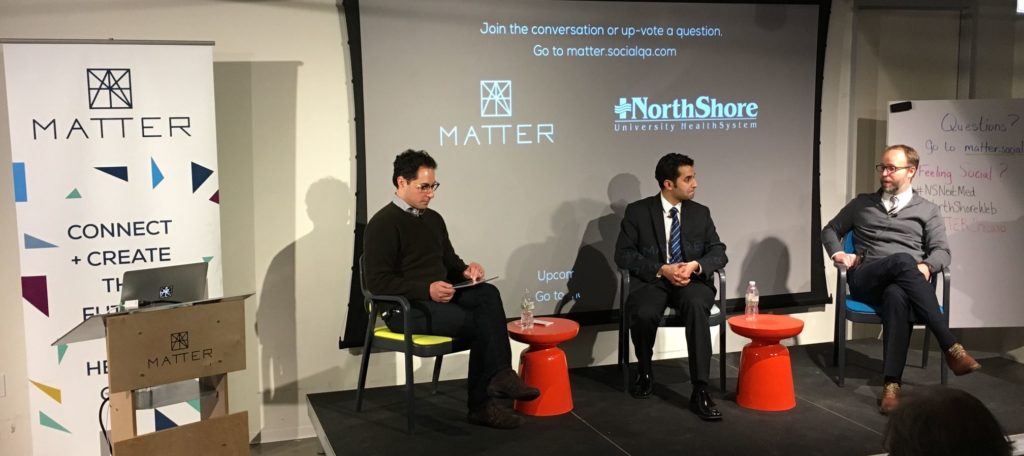Big Data Comes to Healthcare: Identifying High-level Trends to Solve Individual Problems
Today, healthcare leaves a trail of data leading up to and following each patient interaction. From check-ups and surgeries to lab work and prescription refills, every moment of treatment yields a piece of data that could be hugely valuable to clinicians developing treatment plans or health systems streamlining their operations.
Unfortunately, most of this data still largely exists on its own. Most patients’ data is disparate, and the healthcare industry largely hasn’t formed processes to connect individual patient data, let alone the ability to show how individual patient data connects at a population level.
MATTER recently hosted NorthShore University HealthSystem’s analytics director, Chad Konchak, and infectious disease physician Nirav Shah, MD, MPH, for a conversation about their analytics work. Watch highlights of the event:
Chad and Nirav are building meaningful prediction modeling software within the NorthShore system. Their tools allow clinicians to make informed predictions about what will happen in the future for many of their patients, allowing them to make better, timelier decisions to improve outcomes.
The tools they are building are focused on high-priority issues for NorthShore – areas where analytics have the potential to improve outcomes and save costs. They highlighted three examples.
-
Medication non-adherence drives up costs and drives down outcomes. Their solution explores the reasons and likelihood that patients don’t take their prescribed medications. That way, they can identify patients at risk of non-adherence and determine the right ways to motivate them to take their medications.
-
Post-surgery fevers are very common, and it is critically important to separate whether fevers are a normal reaction to surgery or a symptom of an infection. Their tool allows physicians to model expected post-surgical temperature very precisely to reduce unnecessary hospitalization time and costs.
-
Antibiotic resistance is a growing concern for many clinicians who worry about strains of bacteria developing resistance to the medications and becoming harder to treat. Chad and Nirav are identifying patient conditions and responses in relation to antibody development in order to better tailor antibiotic treatment combinations and reduce the risk of population-wide resistance to antibacterial treatments. Their analytics solution allows NorthShore physicians to prescribe the right antibiotics, with the narrowest spectrum, days before the cultures come back from the lab.
We continued the conversation Chad and Nirav began at MATTER last month, asking three questions from the audience that there wasn’t time to answer during the presentation.

Data collection poses a logistical issue. Doctors often don’t have the time to collect and make sense of data if it doesn’t immediately affect the quality of their care. So how do you get doctors on board with a data collection method that will benefit them in the long run, but only if they use it consistently in the short term?
-
Dr. Shah: There’s a strong healthcare culture that exists to prevent the addition of work to primary care physicians, especially since most of that added work doesn’t really provide value to the physician-patient encounter. So, when we try to collect data from physicians or healthcare providers, we must show in real-time the result of entering that data. We really have to show value on the spot.\
-
Chad: In analytics, we’re responding to this call by building the data collection directly into the electronic health record, so that it’s easy and visible and these systems become health learning systems. If you can make it as simple and as direct as possible without having to obstruct existing workflows, physicians will be engaged and interested.
Takeaway: making data collection non-intrusive and proving value on the spot is key to getting clinicians on board.
What challenges and concerns came up when you were developing this software?
-
Dr. Shah: A lot of physicians are hesitant to use these sorts of prediction models out of fear that they won’t be totally accurate. It’s important to look at them as a diagnostic tool, capable of false negatives and false positives. It should guide and inform decision-making, not be the sole decision-maker.\
-
Chad: Even though the data tools we’re building aren’t patient-facing, their outputs allow us to understand how to best engage with patients. How can we analyze how patients consume healthcare information and what types of messaging persuades them to visit their HCP? Maybe one patient responds better to messaging about how easy a procedure is, while another responds well to messaging about how well-trained our doctors are. This information is vital to helping NorthShore get patients to engage in preventative care.
Takeaway: while analytics tools are applied at large scale, and not every recommendation will be accurate, they can improve messaging to patients on the whole and therefore help deliver important care when patients need it.
Any final thoughts to others looking to work in this space?
-
Dr. Shah: Medicine has been so behind the ball in terms of using big data; it’s only fairly recently that we’ve been able to unlock insight from data we collect. In the past 10 to 15 years, we’ve seen an explosion in physicians working more with data scientists to really harness this power. You’re increasingly seeing professionals like “hybrid physicians,” who aren’t only responsible for clinical, but also for interfacing with experts like Chad to turn information into insight.\
-
Chad: It’s a true team effort. My team is building a new tool to help clinicians do what they do best. And when we build it, we must think about how they can most effectively use it. It’s not prescriptive, but it’s more enriched information about what’s happening, and it’s up to the physician to use that information in the course of their care.
Takeaway: while healthcare lags behind many other industries in utilizing data, we are at an inflection point where clinicians and health systems can truly embrace data analytics solutions to solve existing problems and increase quality and efficiency of care.


